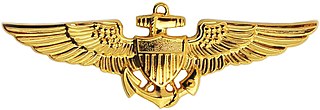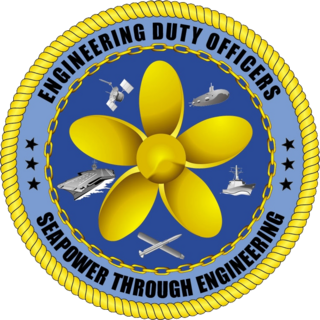
A flight surgeon is a military medical officer practicing in the clinical field of aviation medicine. Although the term "flight surgery" is considered improper by purists, it may occasionally be encountered.
In the United States Navy, officers have various ranks. Equivalency between services is by pay grade. United States Navy commissioned officer ranks have two distinct sets of rank insignia: On dress uniform a series of stripes similar to Commonwealth naval ranks are worn; on service khaki, working uniforms, and special uniform situations, the rank insignia are identical to the equivalent rank in the US Marine Corps.
A naval flight officer (NFO) is a commissioned officer in the United States Navy or United States Marine Corps who specializes in airborne weapons and sensor systems. NFOs are not pilots, but they may perform many "co-pilot" functions, depending on the type of aircraft. Until 1966, their duties were performed by both commissioned officer and senior enlisted naval aviation observers (NAO).

Insignias and badges of the United States Navy are military badges issued by the United States Department of the Navy to naval service members who achieve certain qualifications and accomplishments while serving on both active and reserve duty in the United States Navy. Most naval aviation insignia are also permitted for wear on uniforms of the United States Marine Corps.
In the United States Armed Forces, a line officer or officer of the line is a U.S. Navy or U.S. Marine Corps commissioned officer or warrant officer who exercises general command authority and is eligible for operational command positions, as opposed to officers who normally exercise command authority only within a Navy Staff Corps. The term line officer is also used by the U.S. Air Force and U.S. Coast Guard to indicate that an officer is eligible for command of operational, viz., tactical or combat units. The term is not generally used by officers of the U.S. Army – the roughly corresponding Army terms are basic branch and special branch, qualified officers, although the concepts are not entirely synonymous, as some Army special branch officers are eligible to hold command outside their branch specialty.
A limited duty officer (LDO) is an officer in the United States Navy or United States Marine Corps who was selected for commissioning based on skill and expertise. They are the primary manpower source for technically specific billets not best suited for traditional Unrestricted Line, Restricted Line, or Staff Corps career path officers. Per Title 10, U.S. Code, an LDO is a permanent commissioned officer appointed under section 5589 in a permanent grade above chief warrant officer, W-5, and designated for limited duty.
A restricted line officer is a designator given to a United States Navy and Navy Reserve line officer who is not eligible for Command at Sea. There are many different types and communities, including Engineering Duty Officers, Aerospace Engineering Duty Officers, Aerospace Maintenance Duty Officers, Naval Intelligence Officers, Cryptologic Warfare Officers, Information Operations Officers, Foreign Area Officers, Public Affairs Officers, Naval Oceanographers, Information Professionals, and Human Resources.

A naval aviator is a commissioned officer or warrant officer qualified as a manned aircraft pilot in the United States Navy or United States Marine Corps. While they complete the same undergraduate flight training as Navy and Marine Corps manned aircraft pilots, and are awarded the same aviation breast insignia, a United States Coast Guard manned aircraft pilot is officially designated as a "Coast Guard aviator".
Commodore was an early title and later a rank in the United States Navy, United States Coast Guard and the Confederate States Navy. For over two centuries, the designation has been given varying levels of authority and formality.

The United States Navy's Officer Candidate School provides initial training for officers of the line and select operational staff corps communities in the United States Navy. Along with United States Naval Academy (USNA) and Naval Reserve Officer Training Corps (NROTC), OCS is one of three principal sources of new commissioned naval officers.

In the United States Armed Forces, the ranks of warrant officer are rated as officers above all non-commissioned officers, candidates, cadets, and midshipmen, but subordinate to the lowest officer grade of O‑1. This application differs from the Commonwealth of Nations and other militaries, where warrant officers are the most senior of the other ranks, equivalent to the U.S. Armed Forces grades of E‑8 and E‑9.
A direct commission officer (DCO) is a United States uniformed officer who has received an appointed commission without the typical prerequisites for achieving a commission, such as attending a four-year service academy, a four-year or two-year college ROTC program, or one of the officer candidate school or officer training school programs, the latter OCS/OTS programs typically slightly over three months in length.

An engineering duty officer (EDO) is a restricted line officer in the United States Navy, involved with the design, acquisition, construction, repair, maintenance, conversion, overhaul and disposal of ships, submarines, aircraft carriers, and the systems installed aboard. As of August 1, 2016, there are approximately 835 engineering duty officers on active duty in the U.S. Navy, representing approximately 2 percent of its active-duty commissioned officers.
The US Navy had four programs for the training of naval aviators.

The United States Navy has nearly 500,000 personnel, approximately a quarter of whom are in ready reserve. Of those on active duty, more than eighty percent are enlisted sailors, and around fifteen percent are commissioned officers; the rest are midshipmen of the United States Naval Academy and midshipmen of the Naval Reserve Officer Training Corps at over 180 universities around the country and officer candidates at the navy's Officer Candidate School.

An officer is a member of an armed forces or uniformed service who holds a position of authority.

In the United States Navy, United States Coast Guard, United States Public Health Service Commissioned Corps (USPHS), and National Oceanic and Atmospheric Administration Commissioned Officer Corps, captain is the senior-most commissioned officer rank below that of flag officer. The equivalent rank is colonel in the United States Army, Air Force, Space Force and Marine Corps.
The Gray Owl Award is presented to the naval flight officer (NFO) on continuous active duty in the U.S. Navy or Marine Corps who has held that designation for the longest period of time.








